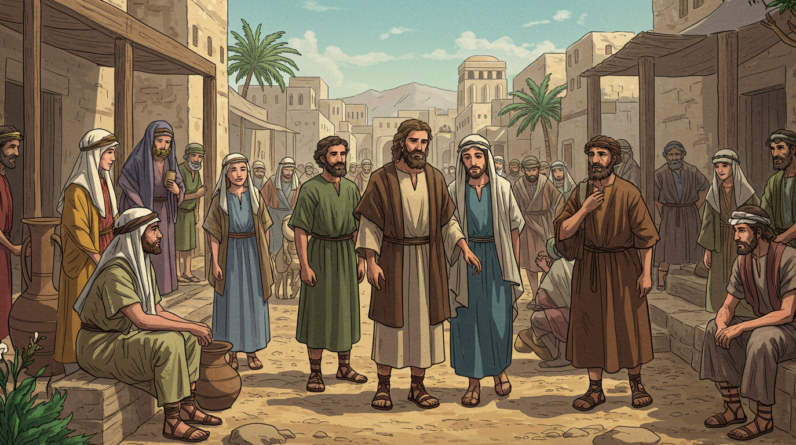Discover the untold story of Jesus’ unnamed sisters in Matthew 13:56 and Mark 6:3. Dive into their silent influence, historical context, and lessons of quiet strength.
Exploring the Unnamed Sisters in Matthew 13:56 and Mark 6:3
Do you ever wonder about the people in Jesus’ life who remain in the shadows, unnamed and often overlooked? It’s easy to focus on the more prominent figures – Mary, Joseph, Peter, or John. Yet, the Gospels also hint at other family members who played roles, albeit less recognized, as the sisters of Jesus mentioned in Matthew 13:56 and Mark 6:3. Their anonymity is intriguing, almost like a perfumed breeze of mystery across the pages of the New Testament. Let’s dive into what little we know about these unnamed sisters and explore their possible influence and significance in Jesus’ life and ministry.

Introduction
Has it ever crossed your mind while reading the Bible about the significance of Jesus’ family beyond the well-known figures like Mary and Joseph? What about those quietly standing on the periphery of his life? The sisters mentioned solely as “sisters” may seem like peripheral characters in the Biblical narrative, yet they offer us themes of faith, familial duty, and care. Though unnamed, their presence reminds us of the often unheralded support and love that underpin every great life.
Biblical Background and Mentions
The Gospel of Matthew provides one of the few glimpses of Jesus’ familial circle in Matthew 13:56: “Aren’t all his sisters with us?” The assertion comes as Jesus returns to his hometown and faces skepticism from those who knew him as a carpenter’s son. Similarly, in Mark 6:3, his townfolk asks, “Isn’t this the carpenter? Isn’t this Mary’s son and the brother of James, Joseph, Judas, and Simon? Aren’t his sisters here with us?” These brief mentions lend credence to the existence of Jesus’ sisters, hinting at their presence and possibly active role in his earthly life. Despite their omissions by name, their thread is woven quietly into his story.
Historical and Cultural Context
To better understand the sisters’ lives, we must transport ourselves to first-century Jewish society. During this era, family was the cornerstone of social structure. Women, though often behind the scenes, played crucial roles in managing households, supporting family enterprises, and nurturing children. The sisters’ role, though not elaborated upon, was likely aligned with these cultural expectations. In Jewish society, the family provided identity, and the home was where faith and tradition were passed down. In this closely-knit environment, Jesus’ unnamed sisters could have very well been influential anchors of love and support.
Their Relationship with Jesus
Imagining their interactions with him can be a delightful spiritual exercise. While the scriptures don’t delve into specific moments, it’s easy to picture a scene from everyday life – perhaps discussions at the dinner table, shared chores or witnessing his teachings evolve. Their familial bond might have been one of warm familiarity, enriched with the unique dynamics that only siblings possess. This silent companionship, the kind only siblings know, may have influenced Jesus subtly in the backdrop of his more overt ministry and mission.
Lessons We Can Learn
From their silent chapters, you can draw abundant lessons on humility and family devotion. In their unspoken presence, you find the embodiment of quiet strength and the essence of steadfast love. Their anonymity teaches us that not all impactful lives are destined for the spotlight; some influence and teach through their steadfast, supportive roles. For contemporary believers, there’s an opportunity to reflect on cherishing and supporting family members, recognizing the value and importance each person brings, regardless of the limelight.
Common Misconceptions and Clarifications
As with many Biblical subjects, myths, and questions abound regarding Jesus’ sisters. Some speculate about the precise number of his sisters or their involvement in his mission. Yet, what remains critical is adhering to the biblical text. No gospel provides names or details, likely highlighting an intentional focus on Jesus’ ministry itself. Rather than detracting from their significance, it emphasizes their unassuming role of support within his conveyed narrative, allowing for the inclusive appreciation of all families.
Conclusion
Even without knowing their names, we uncover a spiritual sibling connection with Jesus’ sisters. In this reflection, perhaps you find parallels in your own family, quietly grateful for those unsung heroes whose support is the backbone of a shared journey. How does their story inspire you to embrace your role, known or otherwise, within the lives of those around you? Maybe it’s time to recognize and appreciate every individual’s role in your spiritual and personal growth.
Acknowledgment: All Bible verses referenced in this article were accessed via Bible Gateway (or Bible Hub).







